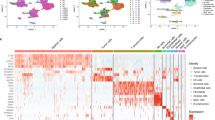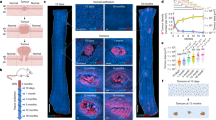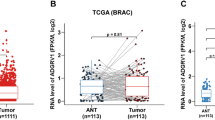Abstract
The efficacy of replication-deficient adenoviral vectors in gene therapy is confined to the number of tumor cells the vector infects. To focus and enhance the therapeutic efficacy, we employed a conditionally replication-competent adenoviral vector with a tissue-specific promoter, DF3/MUC1, in a human esophageal adenocarcinoma model. Our results demonstrate that Ad.DF3.E1A.CMV.TNF (Ad.DF3.TNF) specifically replicates in Bic-1 (DF3-producing cells) and mediates an enhanced biologic effect due to increased TNF-α in the same DF3-producing cells. We also show that the increased TNF-α interacts with ionizing radiation to produce greater tumor regression and a greater delay in tumor regrowth in Bic-1 (DF3-producing cells) compared to Seg-1 (DF3 non-producers). Tumor cell targeting using conditionally replication-competent adenoviral vectors with tumor-specific promoters to drive viral replication and deliver TNF-α provides a novel approach to enhancing tumor radiosensitivity.
This is a preview of subscription content, access via your institution
Access options
Subscribe to this journal
Receive 6 print issues and online access
$259.00 per year
only $43.17 per issue
Buy this article
- Purchase on SpringerLink
- Instant access to full article PDF
Prices may be subject to local taxes which are calculated during checkout





Similar content being viewed by others
References
Zhang WW. Development and application of adenoviral vectors for gene therapy of cancer. Cancer Gene Ther 1999; 6: 113–138.
Danthinne X, Imperiale MJ. Production of first generation adenovirus vectors: a review. Gene Ther 2000;7: 1707–1714.
Walther W, Stein U. Therapeutic genes for cancer gene therapy. Mol Biotechnol 1999; 13: 21–28.
Springer CJ, Niculescu-Duvaz I. Prodrug-activating systems in suicide gene therapy. J Clin Invest 2000; 105: 1161–1167.
Sun WH et al. In vivo cytokine gene transfer by gene gun reduces tumor growth in mice. Proc Natl Acad Sci USA 1995; 92: 2889–2893.
Mauceri HJ et al. Radiation-inducible gene therapy. C R Acad Sci III 1999; 322: 225–228.
Heise C, Kirn DH. Replication-selective adenoviruses as oncolytic agents. J Clin Invest 2000; 105: 847–851.
Cao G et al. Analysis of the human carcinoembryonic antigen promoter core region in colorectal carcinoma-selective cytosine deaminase gene therapy. Cancer Gene Ther 1999; 6: 572–580.
Rodriguez R et al. Prostate attenuated replication competent adenovirus (ARCA) CN706: a selectivecytotoxic for prostate-specific antigen-positive prostate cancer cells. Cancer Res 1997; 57, 2559–2563.
Hallenbeck PL et al. A novel tumor-specific replication-restricted adenoviral vector for gene therapy of hepatocellular carcinoma. Hum Gene Ther 1999; 10: 1721–1733.
Hallahan DE et al. Protein kinase C mediates x-ray inducibility of nuclear signal transducers EGR1 and JUN. Proc Natl Acad Sci USA 1991; 88: 2156–2160.
Hallahan DE et al. Radiation signaling mediated by Jun activation following dissociation from a cell type-specific repressor. J Biol Chem 1993; 268: 4903–4907.
Sherman ML et al. Ionizing radiation regulates expression of the c-jun protooncogene. Proc Natl Acad Sci USA 1990; 87: 5663–5666.
Sherman ML et al. Regulation of tumor necrosis factor gene expression by ionizing radiation in human myeloid leukemia cells and peripheral blood monocytes. J Clin Invest 1991; 87: 1794–1797.
Datta R et al. Ionizing radiation activates transcription of the EGR1 gene via CArG elements. Proc Natl Acad Sci USA 1992; 89, 10 149–10 153.
Datta R et al. Involvement of reactive oxygen intermediates in the induction of c-jun gene transcription by ionizing radiation. Biochemistry 1992; 31: 8300–8306.
Datta R et al. Reactive oxygen intermediates target CC(A/T)6GG sequences to mediate activation of the early growth response 1 transcription factor gene by ionizing radiation. Proc Natl Acad Sci USA 1993; 90: 2419–2422.
Abe M, Kufe D. Structural analysis of the DF3 human breast carcinoma-associated protein. Cancer Res 1989; 49: 2834–2839.
Burdick MD et al. Oligosaccharides expressed on MUC1 produced by pancreatic and colon tumor cell lines. J Biol Chem 1997; 272: 24198–24202.
Kurihara T, Brough DE, Kovesdi I, Kufe DW. Selectivity of a replication-competent adenovirus for human breast carcinoma cells expressing the MUC1 antigen. J Clin Invest 2000; 106: 763–771.
Sersa G, Willingham V, Milas L. Anti-tumor effects of tumor necrosis factor alone or combined with radiotherapy. Int J Cancer 1988; 42: 129–134.
Seung LP et al. Genetic radiotherapy overcomes tumor resistance to cytotoxic agents. Cancer Res 1995; 55: 5561–5565.
El-Serag HB, Mason AC, Petersen N, Key CR. Epidemiological differences between adenocarcinoma of the oesophagus and adenocarcinoma of the gastric cardia in the USA. Gut 2002; 50: 368–372.
Blot WJ, McLaughlin JK. The changing epidemiology of esophageal cancer. Semin Oncol 1999; 26: 2–8.
Devesa SS, Blot WJ, Fraumeni Jr JF. Changing patterns in the incidence of esophageal and gastric carcinoma in the United States. Cancer 1998; 83: 2049–2053.
Bosset JF et al. Chemoradiotherapy followed by surgery compared with surgery alone in squamous-cell cancer of the esophagus. N Engl J Med 1997; 337: 161–167.
Urba SG et al. Randomized trial of preoperative chemoradiation versus surgery alone in patients with locoregional esophageal carcinoma. J Clin Oncol 2001; 19: 305–303.
Walsh TN et al. A comparison of multimodal therapy and surgery for esophageal adenocarcinoma. N Engl J Med 1996; 335: 462–467.
Posner MC et al. Complete 5-year follow-up of a prospective phase II trial of preoperative chemoradiotherapy for esophageal cancer. Surgery 2001; 130: 620–626discussion 626–628.
Chinyama CN et al. Expression of MUC1 and MUC2 mucin gene products in Barrett's metaplasia, dysplasia and adenocarcinoma: an immunopathological study with clinical correlation. Histopathology 1999; 35: 517–524.
Das AK, Walther PJ, Buckley NJ, Poulton SH. Recombinant human tumor necrosis factor alone and with chemotherapeutic agents. Effect on nude mouse-supported human bladder cancer heterografts. Arch Surg 1989; 124: 107–110.
Hallahan DE, Beckett MA, Kufe D, Weichselbaum RR. The interaction between recombinant human tumor necrosis factor and radiation in 13 human tumor cell lines. Int J Radiat Oncol Biol Phys 1990; 19: 69–74.
Mauceri HJ et al. Tumor necrosis factor alpha (TNF-alpha) gene therapy targeted by ionizing radiation selectively damages tumor vasculature. Cancer Res 1996; 56: 4311–4514.
Weichselbaum R et al. Gene therapy targeted by radiation preferentially radiosensitizes tumor cells. Cancer Research 1994; 54: 462–469.
Hallahan DE et al. Spatial and temporal control of gene therapy using ionizing radiation. Nat Med 1995; 1: 786–791.
Staba M-J et al. Adenoviral TNF-a gene therapy and radiation damage tumor vasculature in a human malignant glioma xenograft. Gene Therapy 1998; 5: 293–300.
Chung TD et al. Tumor necrosis factor-alpha-based gene therapy enhances radiation cytotoxicity in human prostate cancer. Cancer Gene Ther 1998; 5: 344–349.
Sugarman BJ et al. Recombinant human tumor necrosis factor-alpha: effects on proliferation of normal and transformed cells in vitro. Science 1985; 230: 943–945.
Asher A et al. Studies on the anti-tumor efficacy of systemically administered recombinant tumor necrosis factor against several murine tumors in vivo. J Immunol 1987; 138: 963–974.
Author information
Authors and Affiliations
Rights and permissions
About this article
Cite this article
Gupta, V., Park, J., Kurihara, T. et al. Selective gene expression using a DF3/MUC1 promoter in a human esophageal adenocarcinoma model. Gene Ther 10, 206–212 (2003). https://doi.org/10.1038/sj.gt.3301867
Received:
Accepted:
Published:
Issue date:
DOI: https://doi.org/10.1038/sj.gt.3301867
Keywords
This article is cited by
-
Combination of E2F-1 promoter-regulated oncolytic adenovirus and cytokine-induced killer cells enhances the antitumor effects in an orthotopic rectal cancer model
Tumor Biology (2014)
-
The Role of Glycogen Synthase Kinase 3-β in Immunity and Cell Cycle: Implications in Esophageal Cancer
Archivum Immunologiae et Therapiae Experimentalis (2014)
-
Effectiveness of HSV-tk Suicide Gene Therapy Driven by the Grp78 Stress-Inducible Promoter in Esophagogastric Junction and Gastric Adenocarcinomas
Journal of Gastrointestinal Surgery (2009)



